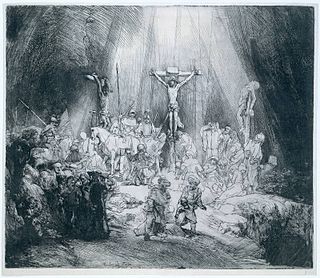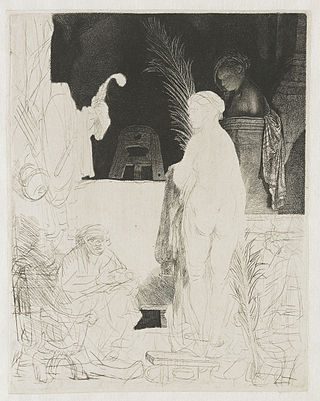
GovertTeuniszoon Flinck was a Dutch painter of the Dutch Golden Age.

Saskia van Uylenburgh was the wife of painter Rembrandt van Rijn. In the course of her life, she was his model for some of his paintings, drawings and etchings. She was the daughter of Rombertus Uylenburg, the mayor as well as the justice of the Court of Friesland.

Abraham Bosse was a French artist, mainly as a printmaker in etching, but also in watercolour.

The Rembrandt House Museum is a museum located in a former house in the Jodenbreestraat, in the center of Amsterdam. Between 1639 and 1658, the house was occupied by the well-known Dutch painter Rembrandt van Rijn, who also had his studio and art dealership there.

The Death of the Virgin Mary is a common subject in Western Christian art, the equivalent of the Dormition of the Theotokos in Eastern Orthodox art. This depiction became less common as the doctrine of the Assumption gained support in the Roman Catholic Church from the Late Middle Ages onward. Although that doctrine avoids stating whether Mary was alive or dead when she was bodily taken up to Heaven, she is normally shown in art as alive. Nothing is said in the Bible about the end of Mary's life, but a tradition dating back to at least the 5th century says the twelve Apostles were miraculously assembled from their far-flung missionary activity to be present at the death, and that is the scene normally depicted, with the apostles gathered round the bed.

Rembrandt Harmenszoon van Rijn, usually simply known as Rembrandt, was a Dutch Golden Age painter, printmaker and draughtsman. An innovative and prolific master in three media, he is generally considered one of the greatest visual artists in the history of art and the most important in Dutch art history. It is estimated Rembrandt produced a total of about three hundred paintings, three hundred etchings and two thousand drawings.

The Virgin and Child with a Cat is an etching made in 1654 by the Dutch artist Rembrandt van Rijn (1606–1669). The Victoria and Albert Museum has in its collection one of the earliest impressions of this etching and the actual copper plate from which the image is taken.

The Stoning of Saint Stephen is the first signed painting by Dutch artist Rembrandt, made in 1625 at the age of 19. one of his earlier works is an oil painting on a wood panel and currently exhibited at the Musée des Beaux-Arts de Lyon.
The Death of the Virgin is a common subject in Christian art, depicting the death of the Virgin Mary.

The dozens of self-portraits by Rembrandt were an important part of his oeuvre. Rembrandt created approaching one hundred self-portraits including over forty paintings, thirty-one etchings and about seven drawings; some remain uncertain as to the identity of either the subject or the artist, or the definition of a portrait.

The Raising of Lazarus is an oil-on-panel painting by the Dutch artist Rembrandt from early in his career; it was probably painted between 1630 and 1632. The work depicts the Raising of Lazarus as told in the Gospel of John, Chapter 11. It is in the collection of the Los Angeles County Museum of Art.

The Three Crosses is a 1653 print in etching and drypoint by the Dutch artist Rembrandt van Rijn, which depicts the crucifixion of Jesus Christ. Most of his prints are mainly in etching and this one is a drypoint with burin adjustments from the third state onwards. It is considered "one of the most dynamic prints ever made".

Self-Portrait at the Age of 34 is a self-portrait by Rembrandt, dating to 1640 and now in the National Gallery in London. The painting is one of many self-portraits by Rembrandt, in both painting and etching, to show the artist in a fancy costume from the previous century. In this case specific influences in the pose have long been recognised from Raphael's Portrait of Baldassare Castiglione and Titian's A Man with a Quilted Sleeve in the National Gallery. Rembrandt saw both of these in Amsterdam, in his day the centre of Europe's art trade, and made a sketch of the Raphael, with its price.

The Goldweigher's Field is a 1651 etching by Rembrandt now held by many museums, including the British Museum, the Rijksmuseum, and the Metropolitan Museum of Art. It is based on a landscape drawing in the collection of the Museum Boijmans van Beuningen.

Descent from the Cross by Torchlight is a print by Rembrandt in etching and drypoint, produced in 1652. Only one state of the work is known, with copies in major collections including the Rijksmuseum, British Museum, and Rembranthuis. It is signed and dated at the bottom right. It was assigned the number B. 83 by Adam von Bartsch. Some late impressions of the work are on Japanese paper, which Rembrandt used more and more from 1650 onwards. The depiction of the shadows on the plate was modified after the artist's death.

The Artist and his Model is a print by Rembrandt, known in two states, both incomplete. Copies of the work are in the British Museum, the Rijksmuseum, the Mikkel Museum, the Saint Louis Art Museum and many other collections. It was numbered B. 1921 by.

Portrait of Jan Six is a 1647 etching by Rembrandt, known in five states. It shows Jan Six, also the subject of a painted portrait by the same artist.

The State Bed is a 1646 print by Rembrandt in etching and drypoint. It is also known as Le Lit à la française, a title first given to it in Edme-François Gersaint's 1751 Catalogue raisonné de toutes les pièces qui forment l’œuvre de Rembrandt.

The Three Trees is a 1643 print in etching and drypoint by Rembrandt, his largest landscape print. It was assigned the number B.212 by Adam von Bartsch and impressions of the work are in the Rijksmuseum, the Musée des beaux-arts du Canada and the Bibliothèque nationale de France.


















